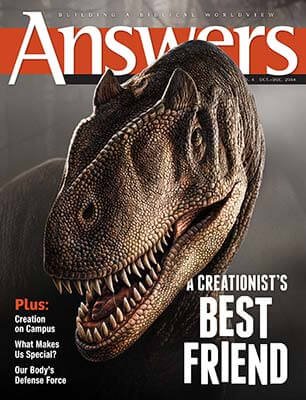God’s Image—The Difference Maker
What Makes Us Special?
Are we just another animal? We can argue about DNA, brain size, and upright stature, but Genesis 1 emphasizes an infinitely greater privilege that sets mankind apart.
Implications of an Anti-Biblical View
Atheism views man as simply a material being like all other animals. In many ways, this is the predominant view of popular culture: man may have “evolutionary advantages” over animals in reason, communication, and some physical abilities but is not a spiritual or sacred being with a purpose and destiny higher than that of the animals.)
In this view, man lives and dies like the beast. Thus concentration camps, gulags, killing fields, and abortion clinics are all monuments to atheism. Such degraded views of man—particularly in denying that man is made in the image of God—inevitably industrialize human misery.
Biblical Worldview
God’s Word, in contrast, views man as the pinnacle of God’s handiwork. On the sixth day of Creation, as His final work, God created man as a physical and spiritual being. His physical aspect was formed from the ground (Genesis 2:7) and his spiritual aspect came from God (Ecclesiastes 12:7). The animals, created on Day Five, resemble man in that they were also formed from the ground (Genesis 2:19) and have the breath of life (Genesis 1:30, 6:17, 7:15, 7:22; Ecclesiastes 3:19). But although the animals resemble man in certain aspects, man surpasses them because God breathed directly into man and because He made man in His own image. Thus God crowned man with glory and majesty to rule over the works of His hand (Psalm 8:5–6).
But what exactly is the image of God and what are the implications of man being made in His image? The answers and applications of such questions are essential to the Christian because they dictate human happiness or wretchedness—and often life and death. The image of God consists of the spiritual part of man that reflects the character of God and is the only firm basis for advocating the dignity of man, the sanctity of life, and the gracious redemption of sinners.
The Image of God: Its Nature
Genesis references the image of God three times (Genesis 1:26–27, 9:6). In Genesis 1:26–27, God made man in His image—a phrase repeated in verse 27 for emphasis—that man might rule over nature. The word image often describes physical objects that are “cut out,” such as the physical images of false gods (2 Kings 11:18) or the golden images (replicas) of the mice and tumors that God had sent as plagues upon the Philistines (1 Samuel 6:5).1
Man was created in His image. This is no idle emphasis. Some interpreters have questioned whether the preposition should be read “as our image” in order to argue for a physical image of God. Others have tried to minimize the implication that we are like God in many ways. But the preposition in is significant here. It depicts the standard or pattern in which God created: God created man in (the pattern of) His image.2 Similarly, in Exodus 25:40, God commanded Moses to make the furniture of the temple “in [the pattern of] their structure.” In Genesis 9:6, the image of God is mentioned again as the reason for capital punishment because man is made in the image of God. In all three cases where the phrase appears in Genesis, God’s image sets man apart from the rest of the earthly creation as a reflection of God, equips man to rule over nature, and ennobles human life.
Being created in the image of God establishes human dignity and sets man above all nature.
The image of God is further explained in Genesis 1:26 by the complementary prepositional phrase “according to our likeness.” Likeness means “resemblance” or “similitude.”3 Often used in comparisons (something is like something else), likeness usually describes appearances (something resembles something else in appearance). Ezekiel, for example, compares the likeness (appearance) of the faces of heavenly beings to the face of man (Ezekiel 1:10). The preposition in the phrase “according to His likeness” means “the like of, like, or as,” so God created man in His image as the like of His likeness. The theologian John Laidlaw opined that the image of God refers to “those features in God of which man is a copy.”4 Simply put, God’s image reflects similarities between God and man.
But how is man similar to God? Certainly, the resemblance excludes the physical body since God is a spirit (John 4:24). Moreover, it excludes creaturely limitations since God is infinite, eternal, and unchangeable in all His attributes (Psalm 90:2; Malachi 3:6; Jeremiah 23:24). Man resembles God in having a free, rational, personal spirit, including a conscience with God’s law written upon his heart (Romans 2:14–16); therefore, man can rule over nature in a way similar to how God reigns.5 The Targums, the official interpretation of the synagogue in the time of Christ, explain man’s rational, personal spirit in Genesis 2:7: “And it [the breath of life] became in man as a spirit that speaks.” Human beings, in contrast with the animals, can reason, converse, and fellowship with each other. But most important, because man resembles God spiritually, he can fellowship with God.
But to fellowship with God, the image of God in man must reflect God’s holy character, especially in knowledge, righteousness, and holiness—as characterized by and the products of the truth. In Colossians 3:10, Paul speaks of God’s image: “And [we] have put on the new man who is renewed in knowledge according to the image of Him who created him.” In regeneration, God is renewing His image within us in the true knowledge of God. Such knowledge of God is eternal life.
In the parallel passage, Ephesians 4:24, Paul writes, “And that you put on the new man which was created according to [the image of]6 God, in true righteousness and holiness.” Paul reveals that God’s image includes more than a free, rational, personal spirit but that God’s image originally possessed a knowledge of God, righteousness, and holiness that was permeated by truth. This type of righteousness and holiness reflects God’s moral excellence. Again, humanity’s resemblance to God is spiritual. Sin destroyed the original knowledge, righteousness, and holiness that Adam possessed; so man is born alienated from God, “dead in trespasses and sins” (Ephesians 2:1), though still possessing the image of God now damaged by sin. Regeneration, however, begins the process of renewing the image of God by restoring the lost knowledge, righteousness, and holiness in the believer. This process continues to the end of the believer’s earthly life.
But even at death, when body and spirit are separated, God’s image in man continues. John, for instance, speaks of the souls under the altar (Revelation 6:9–11), the disembodied souls of departed saints awaiting the resurrection. Although without a physical brain, they remember their martyrdom, have a sense of justice, express emotions, and even desire vengeance. Although without a physical mouth and vocal cords, they cry out and communicate, and even raise their voices aloud. Although without a physical body, they are given spiritual robes, as they wait for justice.
As disembodied spirits, believers retain God’s image. In fact, at death in the disembodied state, our spirits will be made perfect in resembling God (Hebrews 12:23). At the resurrection, our natural body, which bears the image of the earthly (not of God) and is sown in the earth at death, will be raised a spiritual body. Then, our bodies will also bear the image of the heavenly (of God), just as our spirits do now (1 Corinthians 15:35–49).
The Image of God: Its Implication
Because he is a spiritual being made in God’s image, man resembles and reflects God. This has profound implications.
First, the image of God establishes human dignity. By denying God’s image, atheism diminishes human dignity by reducing man to a chance, evolutionary product of matter, a mere animal. Pantheism, at the other extreme, also denies the image of God and diminishes human dignity by exalting all nature as a manifestation of God. The Scriptures, by contrast, testify to man’s dignity: “For You have made him a little lower than the angels, and You have crowned him with glory and honor” (Psalm 8:5). Being created in the image and after the likeness of God sets man above all nature. According to Christ, one human soul is more valuable than the rest of nature (Matthew 6:26; Mark 8:36). In fact, God indicated His value of the soul by sending His Son to redeem it. This does not, to be sure, devalue the rest of nature because God created it as well. Man in God’s image should rule nature benevolently as good stewards of God’s creation. Nevertheless, as the Jewish scholar Kaufman Kohler wrote, “that which distinguishes man from the animal as well as from the rest of creation . . . is his self-conscious personality . . . through which he feels himself akin with God.”7 No human condition mitigates this truth, whether it is physical limitation, deformity, or cognitive capacity. Sin alone has a debilitating effect (Romans 1:21–25, 3:9–18, 5:12), but it can only damage the image of God, not remove it. Not even naked lunatics living in tombs or paralytics on the side of the road were beyond human dignity and Christ’s compassion (Matthew 4:24, 17:15; Mark 5:1–13).
Second, the image of God establishes the sanctity of life. Atheistic cultures reject the sanctity of life by devaluing the life of the born and unborn as state policy. The Word of God, however, protects the sanctity of life in its laws. In Genesis 9:5–6, God decrees that if anyone commits murder, the murderer must forfeit his life, because man is made in the image of God. The crime, therefore, is a direct assault against God. The personal tone and the threefold repetition of the verb in Genesis 9:5 emphasize the gravity of this crime against God: “And surely your lifeblood I will require, from the hand of every living being I will certainly require it. From the hand of man, from the hand of each man I will require the life of man” (authors’ translation). God will personally seek out the murderer and hold him accountable. God’s retribution is sure. John Calvin observed that because man is God’s image-bearer, God deems Himself “violated in their person [the victim]” and one cannot injure another human being “without in a sense wounding God Himself.”8 Rabbinic literature also speaks of “impairing” the divine likeness through homicide.9 God created man’s life sacred—to destroy this life invites divine judgment.
Third, the image of God establishes the need for God’s redemption. Without God’s image in man, the plan of redemption would not exist. This does not imply that possessing the image of God entitles sinners to redemption, but redemption requires that sinners have been made in His image. God’s purpose for sending His Son in the likeness of man was to renew God’s image in mankind through the gospel (Ephesians 4:24; Colossians 3:10). Indeed, Christians have been foreknown and predestined to be conformed to the image of His Son (Romans 8:29). As image-bearers, we are uniquely set apart from creation, including angels (1 Peter 1:12), to be restored to fellowship with God the Father and His Son (1 John 1:3). The gospel, once received, renews the image that was marred by both Adam’s sin and our own sin so that the believer may “bear the image of the heavenly” (1 Corinthians 15:49). Because God created us in His image, being crowned with glory and honor, and because of His infinite grace toward undeserving sinners, God sent His Son to redeem us.
Human beings bear the spiritual image of their Creator. As image-bearers, we all have value no matter our abilities or status in this life. As image-bearers, we realize that each one of our lives is sacred. As image-bearers marred by the Fall, we need a Savior. And as image-bearers, we are called by our Creator’s redeeming love to be renewed and conformed into the image of Jesus Christ, who is the perfect, beautiful image of God.
Answers Magazine
October – December 2014
This issue explores the marvelous human immune system. Plus take a look at the Creation Museum's new Allosaurus.
Browse Issue SubscribeFootnotes
- F. Brown, S. R. Driver, and C. A. Briggs, Hebrew and English Lexicon of the Old Testament (Oxford, 1906), 853b 1.
- Ibid, 190b, III, 8.
- Ibid., 198a.
- John Laidlaw, The Bible Doctrine of Man, p. 118.
- Note also that it does not devalue the human body, because together with the spirit that bears the image of God, man is a living being. And as a physical being, he rules over physical nature.
- The Greek literally reads, “And to put on the new man, the (man) having been created according to God in righteousness and holiness of the truth.” Colossians 3:10 parallels and complements the teaching of Ephesians 4:24, explaining the key words, “according to God,” as “according to the image of Him who created him. “According to God” in Ephesians 4:24, therefore, should be understood as “according to the image of God.”
- Kaufmann Kohler, Jewish Theology: Systematically and Historically Considered (BookMasters: Kindle edition).
- John Calvin, Genesis (Wheaton: Crossway Books, 2001), p. 90.
- Bereishis = Genesis: a New Translation with a Commentary Anthologized from Talmudic, Midrashic and Rabbinic Sources, vol. 1, 1st ed, ArtScroll Tanach Series (New York: Mesorah Publications, 1977), p. 291.
Recommended Resources

Answers in Genesis is an apologetics ministry, dedicated to helping Christians defend their faith and proclaim the good news of Jesus Christ.
- Customer Service 800.778.3390
- © 2024 Answers in Genesis







